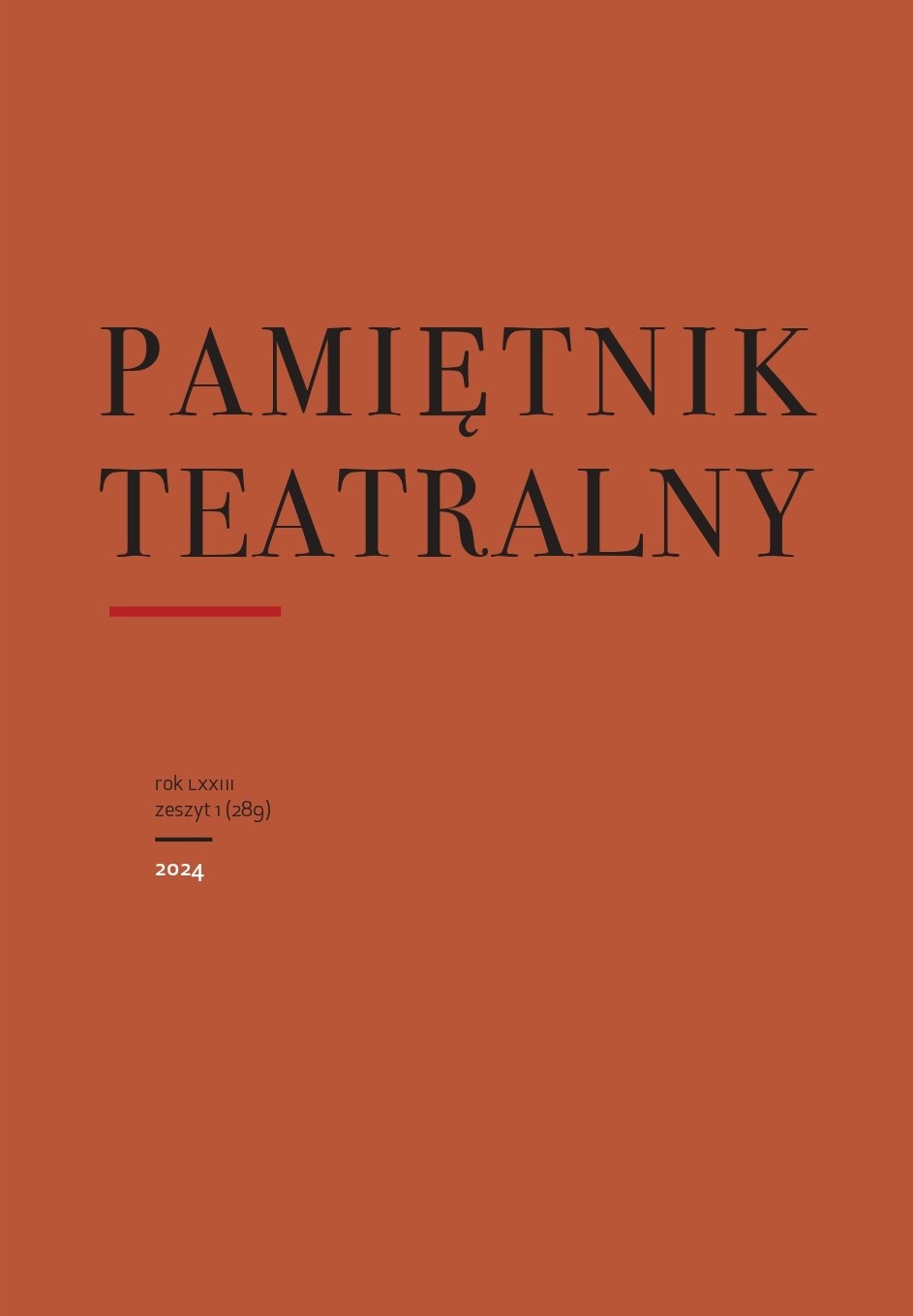Can Theatre Help Repair Damaged Urban Fabric? Toward a “Thick” Description of Haifa’s Wadi Salib Theatre Center
Abstrakt
Artykuł omawia funkcje teatru jako miejskiej instytucji kulturalnej w polityce, organizmie miejskim i wyobraźni przestrzennej Hajfy, „zranionego miasta” (Till, 2012) przenikniętego żydowskimi i palestyńskimi historiami. Studium przypadku dotyczy centrum teatralnego w Wadi Salib, założonego w 1983 roku w palestyńskim budynku. W wybranym przez autorkę modelu historiograficznego myślenia kluczową rolę odgrywają kryzysy, gasnące nadzieje, a nawet porażki, które ograniczają poczucie, że twórcy teatralni mogą wprowadzać zmiany, łagodzić rany wspólnoty i pobudzać krytyczny dyskurs. Autorka analizuje funkcjonowanie centrum teatralnego w trzech wymiarach przestrzennych: historycznego budynku i jego lokalizacji, przestrzeni teatralnej, a następnie zaadaptowanego kompleksu Al-Pasha jako ruiny. Dowodzi, że działalność ośrodka odsłoniła zarówno zranioną tkankę miejską, jak i instytucjonalną niewydolność teatru – nawet częściowo finansowanego ze środków miejskich i rządowych – jako aktywnego, stabilnego i sprawczego uczestnika procesu pojednania i uzdrawiania.
Słowa kluczowe:
teatr w zaadaptowanym budynku, teatr miejski, żydowskość, palestyńskość, arabskość, teatr w Izraelu, Wadi Salib, ruinyBibliografia
Aronson-Lehavi, Sharon, and Freddie Rokem. “Word and Action in Israeli Performance.” In Contesting Performance: Global Sites of Research, edited by Jon McKenzie, Heike Roms, and C. J. Wan-Ling, 222–235. Basingstoke: Palgrave Macmillan, 2012.
DOI: https://doi.org/10.1057/9780230279421_14
Google Scholar
Ben-Artzi, Yossi. The Creation of the Carmel as a Segregated Jewish Residential Space in Haifa, 1918–1949. [In Hebrew]. Jerusalem: Hebrew University Magnes Press, 2004.
Google Scholar
Ben-Artzi, Yossi. “Wadi Salib and Its Role in the Development of Haifa.” [In Hebrew]. In Requiem to Wadi Salib, curator Gershon Knispel. Haifa: Bet HaYotzer, 1989.
Google Scholar
Ben-Zvi, Linda. “Godot in Israel.” Journal of Beckett Studies, no. 11/12 (1989): 230–234. https://www.jstor.org/stable/44783083.
Google Scholar
Carlson, Marvin. The Haunted Stage: The Theatre as Memory Machine. Ann Arbor:University of Michigan Press, 2002.
DOI: https://doi.org/10.3998/mpub.17168
Google Scholar
Carlson, Marvin. Places of Performance: The Semiotics of Theatre Architecture. Ithaca: Cornell University Press, 1989.
Google Scholar
Chaudhuri, Una. Staging Place: The Geography of Modern Drama. Ann Arbor: University of Michigan Press, 1995.
DOI: https://doi.org/10.3998/mpub.10540
Google Scholar
Fugard, Athol, John Kani, and Winston Ntshona. “The Island.” In Statements, 45–77. New York: Theatre Communications Group, 1986.
Google Scholar
Goren, Tamir. “Biography of a Neighborhood.” [In Hebrew]. Cathedra: For the History of Eretz Israel and Its Yishuv, no. 133 (2009): 161–164. https://www.jstor.org/stable/23408345.
Google Scholar
Harvie, Jen. Theatre and the City. London: Palgrave Macmillan, 2009.
DOI: https://doi.org/10.1007/978-0-230-36467-7
Google Scholar
Levy, Shimon. Samuel Beckett’s Self-Referential Drama: The Three I’s. London: Palgrave Macmillan, 1990.
DOI: https://doi.org/10.1007/978-1-349-10969-2
Google Scholar
McKinnie, Michael. City Stages: Theatre and Urban Space in a Global City. Toronto: University of Toronto Press, 2009.
Google Scholar
Mitchell, W. J. T. Sacred Landscape. [In Hebrew]. Translated by Rona Cohen. Tel Aviv: Resling, 2010.
Google Scholar
Morris, Benny. The Birth of the Palestinian Refugee Problem, 1947–1949. [In Hebrew]. Tel Aviv: Am Oved Publishers, 1991.
Google Scholar
Rotbard, Sharon. White City, Black City. [In Hebrew]. Tel Aviv: Babel, 2005.
Google Scholar
Snir, Reuven. “Palestinian Theatre: Historical Development and Contemporary Distinctive Identity.” Contemporary Theatre Review 3, no. 2 (1995): 29–73. https://doi.org/10.1080/10486809508568338.
DOI: https://doi.org/10.1080/10486809508568338
Google Scholar
Stoler, Ann Laura. “Imperial Debris: Reflections on Ruins and Ruination.” Cultural Anthropology 23, no. 2 (2008): 191–219. https://www.jstor.org/stable/20484502.
DOI: https://doi.org/10.1111/j.1548-1360.2008.00007.x
Google Scholar
Till, Karen E. “Wounded Cities: Memory-Work and a Place-Based Ethics of Care.” Political Geography 31 (2012): 3–14. https://doi.org/10.1016/j.polgeo.2011.10.008.
DOI: https://doi.org/10.1016/j.polgeo.2011.10.008
Google Scholar
Tompkins, Joanne. Unsettling Space: Contestations in Contemporary Australian Theatre. London: Palgrave Macmillan, 2006.
DOI: https://doi.org/10.1057/9780230286245
Google Scholar
Urian, Dan. The Arab in Israeli Drama and Theatre. London: Routledge, 1997.
Google Scholar
Weiss, Yifat. Wadi Salib: A Confiscated Memory. [In Hebrew]. Tel Aviv: Hakibbutz Hameuchad Publishing House, 2007.
Google Scholar
Autorzy
Dorit Yerushalmidyerush1@univ.haifa.ac.il
The University of Haifa, Israel Izrael
Dorit Yerushalmi - PhD, wykładowczyni na Wydziale Studiów nad Teatrem i Widowiskami na Uniwersytecie w Hajfie, była kierowniczka Wydziału. Jej badania koncentrują się na historiografii teatru hebrajskiego, estetyce i aspektach ideologicznych twórczości współczesnych reżyserów izraelskich oraz teatrze w "miastach mieszanych". Jest autorką The Directors’ Stage: on Directors in the Israeli Theatre (2013) i współredaktorką tomów: Please Don’t Chase Me Away: New Studies on the Dybbuk (2009) i Habima: New Approaches to National Theatre (2017). Opublikowała też wiele artykułów naukowych w czasopismach takich jak: Journal of Modern Jewish Studies, New Theatre Quarterly, T.D.R: The Drama Review and Performance Research.
Statystyki
Abstract views: 570PDF downloads: 417
Licencja
Prawa autorskie (c) 2022 Dorit Yerushalmi

Utwór dostępny jest na licencji Creative Commons Uznanie autorstwa – Użycie niekomercyjne – Bez utworów zależnych 4.0 Międzynarodowe.
Autor/ka udziela niewyłącznej i nieodpłatnej licencji (CC BY 4.0) na wykorzystanie tekstu w "Pamiętniku Teatralnym", zachowuje nieograniczone prawa autorskie, ale zobowiązuje się do podawania miejsca pierwodruku przy ponownym wykorzystaniu artykułu (umowa licencyjna do pobrania). Zgłaszając artykuł do publikacji, autor/ka wyraża zgodę na jego udostępnianie na licencji CC BY 4.0.
Od zeszytu 1/2018 do zeszytu 3/2022 artykuły publikowane były na licencji CC BY-NC-ND 4.0. W tym okresie autorzy/ki udzielali niewyłącznej i nieodpłatnej licencji (CC BY-ND 4.0) na wykorzystanie tekstu w "Pamiętniku Teatralnym", zachowywali nieograniczone prawa autorskie, ale zobowiązywali się do podawania miejsca pierwodruku przy ponownym wykorzystaniu artykułu.









